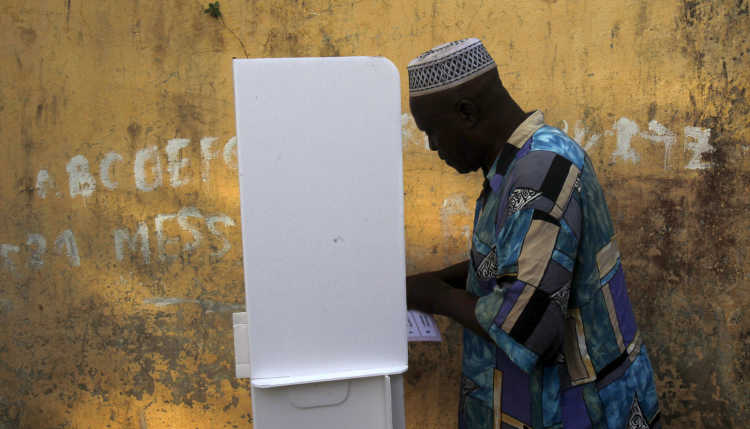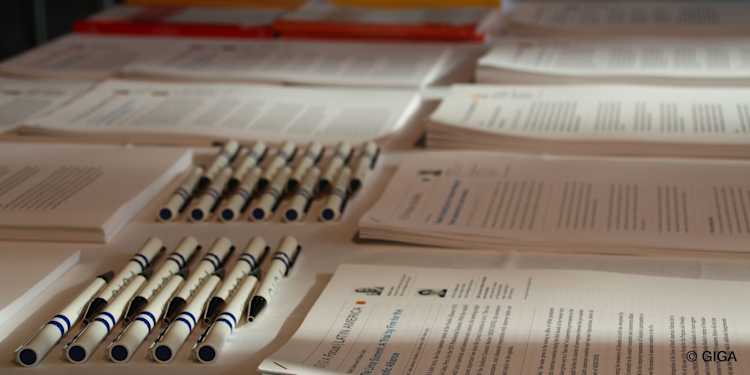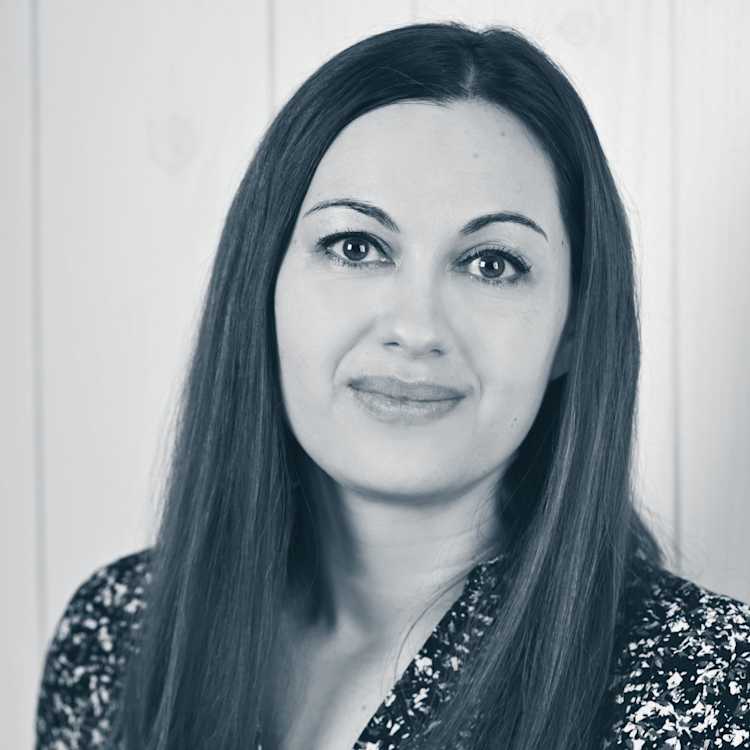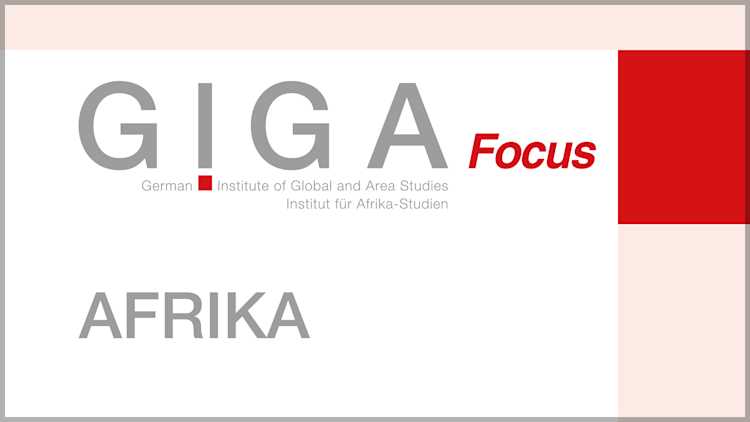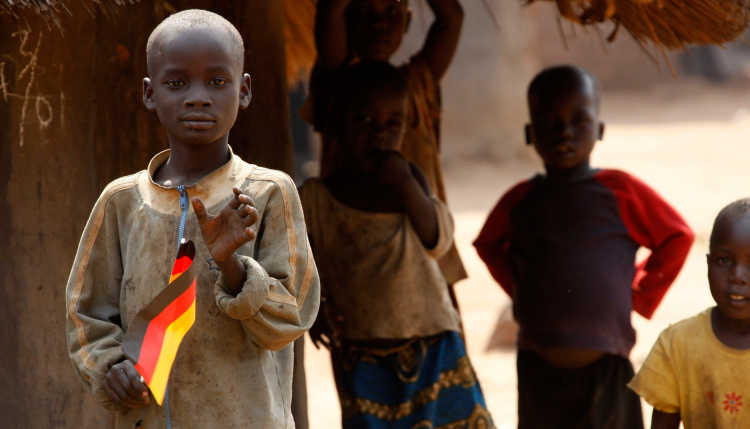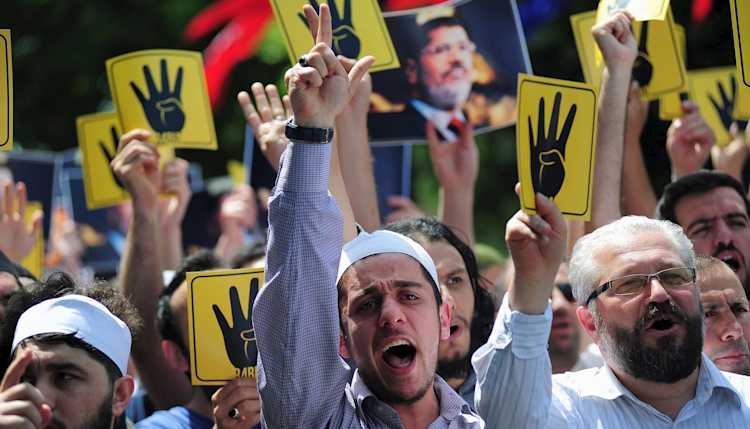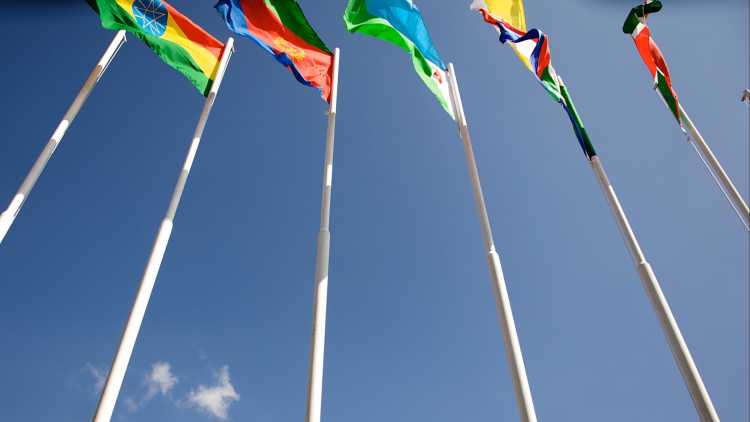- Startseite
- Publikationen
- GIGA Focus
- The Rise of Religious Armed Conflicts in Sub-Saharan Africa: No Simple Answers
GIGA Focus Afrika
Religiöse Konflikte auf dem Vormarsch in Subsahara-Afrika: Keine einfachen Erklärungen und Lösungen
Nummer 4 | 2017 | ISSN: 1862-3603

Im Juni 2017 erklärte die EU, Länder im Sahel stärker im Kampf gegen religiöse Extremisten zu unterstützen. Tatsächlich stellen religiöse Konflikte ein großes Problem dar: Mitte des Jahres 2017 zeigen acht von zehn aktiven bewaffneten Konflikten eine religiöse Dimension. Die Konflikte lassen sich in „interreligiöse Konflikte“ aufgrund der religiösen Zugehörigkeit und in „theologische Konflikte“ mit unvereinbaren Ideen über die Rolle von Religion im Staat unterscheiden. Die Zahl theologischer Konflikte ist zuletzt stark gestiegen.
Die geografischen Schwerpunkte von theologischen Konflikten sind der Sahel, Nigeria und Somalia. Alle diese Konflikte haben auf Nachbarländer übergegriffen. Die Folgen sind dramatisch. Tausende Menschen starben, Millionen sind auf der Flucht. Die Gewalt untergräbt die politische, soziale und wirtschaftliche Entwicklung der betroffenen Länder.
Die Mehrzahl der theologischen Konflikte sind mit dem Islamismus verknüpft. Es gibt oder gab in Ländern wie der Republik Kongo, der Demokratischen Republik Kongo und Uganda aber auch christlich motivierte Rebellen. Länder mit gemischter religiöser Bevölkerung sind anfällig für interreligiöse Konflikte, die in Ländern wie der Elfenbeinküste, Nigeria oder der Zentralafrikanischen Republik ausbrachen.
Die Ursachen dieser Konflikte sind nicht eindeutig. Offenbar mischen sich religiöse mit anderen Faktoren. Wenn religiöse und ethnische Gruppengrenzen überlappen, steigt das Risiko interreligiöser Konflikte. Schwache Staatlichkeit erleichtert religiös motivierten Rebellen ihre Operationen; schlechte Regierungsführung macht ihre Ideologie für die Bevölkerung attraktiver. Externe Unterstützung religiöser Extremisten aus Nordafrika und dem Nahen Osten stellt ein gesondertes Problem dar.
Fazit
Es gibt keine einfachen Lösungen. Gegenmaßnahmen müssen religiöse und nichtreligiöse Ursachen bekämpfen und sowohl Sicherheit als auch Entwicklung berücksichtigen. Entwicklung verhindert religiöse Gewalt langfristig, aber Sicherheitsoperationen sind gegen aktuelle Bedrohungen unerlässlich. Internationale Akteure sollten afrikanische Regierungen unterstützen, aber alle Maßnahmen werden nur nachhaltig sein, wenn sie auf afrikanischen Interessen und Fähigkeiten beruhen.
Religious Violence in Africa has Become Frequent and is Increasing
Since the 1990s, the deadliness of armed conflict and other violence seems to have decreased in sub-Saharan Africa and throughout the world (Pinker 2011; Basedau and Mappes 2015). There are signs, however, that this might be changing. Religious violence has apparently become a widespread phenomenon in sub-Saharan Africa, while terrorist attacks have killed many civilians in Burkina Faso, Chad, Côte d’Ivoire, Kenya, Mali, Nigeria, and Somalia. In Mali, Nigeria, and Somalia jihadist organisations have staged rebellions and managed to at least temporarily control large parts of the territory of these states. In the Central African Republic (CAR), a Muslim rebellion ousted a Christian-dominated government; the ensuing turmoil escalated into bloody confrontations between Muslim and Christian militias and left thousands of civilians dead.
What does the bigger picture look like beyond anecdotal evidence? First, we have to clarify the kind of violence we are discussing. Although there are various types of (religious) violence, here I concentrate on armed conflicts. According to the Uppsala Conflict Data Program (UCDP), armed conflict is an organised form of violence between the state and a non-state rebel group or militia that leads to violence with at least 25 battle-related deaths in one year. Armed conflicts are different from isolated terrorist attacks against civilians and clashes between non-state militias or other actors, though they are often closely connected to such forms of violence.
What are religious armed conflicts? In the scientific literature, scholars generally distinguish between two types (see, e.g., Svensson 2007; Fox 2012; Basedau, Pfeiffer, and Vüllers 2016). The first kind, “interreligious armed conflicts,” refer to violence between factions that differ according to their religious identities – for example, Muslims and Christians. The second kind, “theological armed conflicts,” refer to violence between parties that are incompatible with regard to religious ideas – for instance, the role of religion in the state. Theological armed conflicts are also often Islamist conflicts, as can be seen in Nigeria or Somalia. However, they are not necessarily tied to one particular faith. It has to be understood that religious incompatibilities are merely dimensions of a conflict and that all religious conflicts can also include other non-religious incompatibilities, like ethnicity or natural resources. Thus, while we can speak of religious dimensions of armed conflicts, there is no such thing as a purely “religious conflict.”
Table 1 provides a snapshot of all active armed conflicts and civil wars in sub-Saharan Africa for the end of 2016. The table is by and large valid for the first six months of 2017 as well. The basic source is UCDP that captures all armed conflicts until the end of 2016 (see Allansson, Melander, and Themnér 2017). Following the global trend, the majority of them are primarily intrastate armed conflicts. Of the 10 truly intrastate armed conflicts, excluding the three cases with external rebels only, 8 have a clear religious dimension. In Mali, Nigeria, and Somalia Islamist rebels are fighting largely secular governments. In Congo-Brazzaville, the so-called Ntsiloulous rebels – led by the Protestant extremist Pasteur Ntoumi – are also fighting a secular government. In Sudan (in the states of South Kordofan and Blue Nile) partly secular rebels are confronting an Islamist government. The conflict in South Kordofan also has a weak interreligious dimension as the rebels are partly Christians and animists while the government is dominated by Muslims. In Uganda Muslim rebels are fighting against the Christian and secular government – though their Islamist orientation is unclear. The conflict in Ogaden, Ethiopia, is mainly interreligious, i.e. between Muslim rebels and a mainly Christian government, but hardly being driven by religious ideas. In Nigeria, the Muslim rebels are fighting against the religiously mixed and secular federal government and military; however, the interreligious character is less pronounced as the conflict is occurring in the country’s overwhelmingly Muslim northern states. The armed conflicts in Rwanda, Mozambique, and South Sudan – as well as the less active conflicts in Burundi and the Democratic Republic of the Congo (DRC) – have no religious dimension according to our definitions.
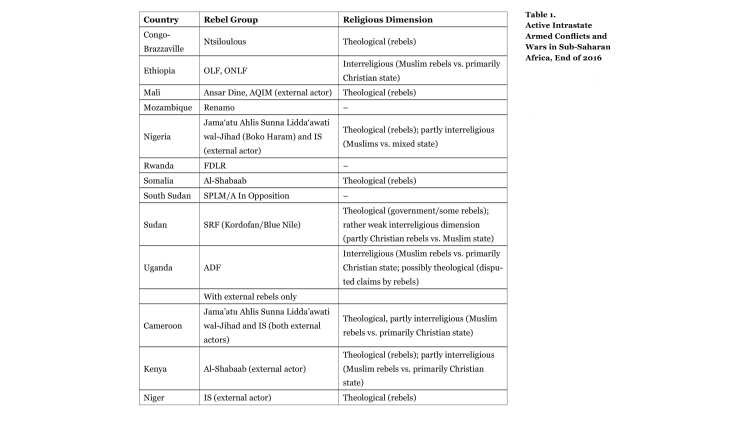
The Religion and Rebels data set (R&R data set), which covers the years from 1946 to 2013, reveals that idea-based religious armed conflicts have been strongly increasing in the last decades. Building on the UCDP data set on armed conflict, the R&R data set additionally distinguishes between (idea-based) theological and (identity-based) interreligious conflicts (Basedau and Rudolfsen 2016). In the case of Africa, it makes sense to start in 1960 because very few countries were independent before then. Figure 1 shows the relative share of interreligious and theological conflicts from 1960 to 2013. It demonstrates that although interreligious conflicts have formed a substantial share of conflict since 1960, their share has generally been decreasing. In contrast, theological conflicts were virtually absent until the mid 1980s but have steadily grown since. In fact, they accounted for more than 40 per cent of armed conflicts in 2013 – the last year of systematic observation in the data set. These numbers by and large match the snapshot of mid-2017, which reveals that at least 50 per cent of armed conflicts were theological in nature while 40 per cent were interreligious. These trends largely conform to global developments.
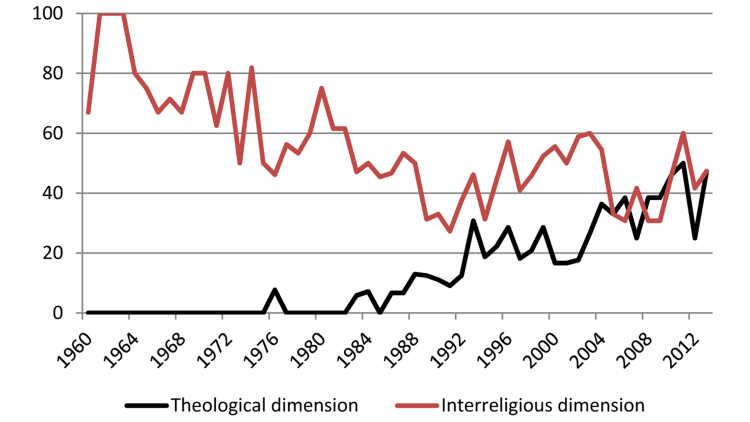
Harmful Consequences
Obviously, the problem is substantial and has the potential to grow. Regarding interreligious conflicts, countries with mixed religious populations in coastal countries in West and East Africa are at risk of an escalation into violence, as has been the case in Ethiopia, Côte d’Ivoire, Sudan, and the Central African Republic. The geographical hotspots of theological armed conflicts are the Sahel, specifically Mali, Nigeria, and Somalia. The Islamist rebels in these countries have ties to global groups like al-Qaida and the Islamic State (IS). Although Islamists have been weakened in Mali and Nigeria in recent years and months, these conflicts have spilled over into neighbouring countries. The Sahel region as a whole is constantly under threat: Nigeria’s Boko Haram (officially called Jama‘atu Ahlis Sunna Lidda‘awati wal-Jihad) has staged attacks in Cameroon, Chad, and Niger, while terrorists tied to the Somali group Al-Shabaab have attacked civilian targets in Kenya and Uganda (see Table 1). This violence has resulted in substantial bloodshed. According to the UCDP, the conflict in Nigeria involving Boko Haram has claimed the lives of more than 20,000 people since 2009. In Somalia, more than 30,000 have perished since the early 1990s. The number of people killed in clashes between Muslim herders and Christian farmers in Nigeria’s middle belt exceeds 10,000. Thousands have also been killed in the CAR. These numbers only include direct battle-related deaths and not indirect deaths that result from worsened living conditions. Millions have become internally displaced persons (IDPs) or have fled to neighbouring or Western countries because of these conflicts. Violent conflict – whether religious or not – always severely hinders sound economic, political, and social development.
Not Just Islam: A Mix of Causes
While it is obvious that we are facing a significant challenge, its causes are far from being fully understood. There are no comprehensive and exhausting studies, and analyses of the causes reflect more or less educated guessing (see, e.g., UNDP 2016). Presently, scholars hotly debate several potential causes of conflicts with a theological dimension (interreligious conflicts follow a somewhat different logic).
The first debate concerns the role of religion and particular faiths. Most theological conflicts involve Islamist actors, either governments or rebels. And as in recent worldwide developments, the majority of theological conflicts in sub-Saharan Africa have a strong connection to (Sunni) Islamism. However, this is a relative finding and does not hold true for interreligious conflicts – which involve all kinds of faith. Moreover, in sub-Saharan Africa, Christian rebels have made theological claims, such as Ntsiloulous in Congo-Brazzaville and the Lord’s Resistance Army (LRA) in Uganda. Moreover, Bundu dia Kongo, a group that blends separatism and traditional African religion with Christianity, clashed with DRC security forces in 2007 and 2008. There are other (mostly Christian) cults that have engaged in violence in countries like Burundi and Nigeria. African Traditional Religion (ATR) seems to be less connected to organised violence – this faith is sometimes apparently linked to unorganised forms such as ritual murder and “witch” killings.
Even if we acknowledge that most theological conflicts involve Islamists, it would be grossly misleading to equate Islamists to Muslims. The increasing number of conflicts cannot be explained by the presence of Muslims, which has not increased correspondingly. As shown by survey data from the Pew Research Center from 2010 and 2013 (Pew Research Center 2010, 2013), only a minority of African Muslims support religious extremism. On average, 29 per cent of all Muslim respondents felt that attacking civilians in defence of one’s religion was often or sometimes justified (on average 19 per cent of Christians agreed on the same question). In another survey (Poushter 2015), more than 60 per cent of the respondents in Burkina Faso, Nigeria, and Senegal rejected IS. In those countries no more than a maximum of 14 per cent openly supported IS; however, the actual number of supporters could be higher given the uneasy finding that at least 20 per cent answered the same question with “don’t know.” At least initially, Boko Haram probably had more support among the population in Nigeria’s northern states.
On the whole, Muslims and Islam in sub-Saharan Africa have traditionally been peaceful and moderate. While Nigeria has always had a substantial share of fundamentalist Muslims, radicalisation seems to have been, at least partially, imported from neighbouring North Africa and the Middle East. For instance, the Islamist rebellion in Mali is a spillover from Algeria, and Algerian extremists played a key part in the country’s 2012 rebellion. The Islamist rebels were also reinforced by mercenaries formerly with the Libyan forces, who fled Libya after the fall of Gaddafi. Saudi Arabia, in particular, is also another possible source of ideological radicalisation, spreading the fundamentalist version of Wahabi Islam through oil money and other channels (Dorsey 2017; see also Kovacs 2014). There, like in Qatar, it is probably not the direct funding of violence but rather the spread of ultra-conservative interpretations of Islam that is “creating Frankenstein” (Dorsey 2017). There is also evidence that the original leader of (Sunni) Boko Haram found refuge from the Nigerian police in Saudi Arabia in 2005, while Iyad Ag Ghali, the founder of the Malian Islamist rebel group Ansar Dine, started his rebellion after experiencing a religious rebirth during his assignment as a Malian diplomat in Saudi Arabia. Furthermore, Iran helped to create a radical Shiite minority in Nigeria.
Religious ideas do not necessarily cause radicalisation. For the most part, the religious values and norms within Islam, Christianity, and other faiths are actually in favour of peace. In fact, many religious actors form interreligious networks to directly engage in peace activities, which – according to GIGA data – are frequent around the world and in sub-Saharan Africa (Vüllers et al. 2015). Therefore, analyses have to consider non-religious contexts. Often, religious and ethnic differences run parallel in countries with diverse populations like the CAR and Nigeria. Such identity overlaps have proven to be a determinant of religious and other armed conflicts (Basedau, Pfeiffer, and Vüllers 2016), especially when combined with feelings of marginalisation.
The effects of weak states and poor governance also contribute to such conflicts. The lack of social and economic development and corrupt politicians in various countries make parts of their populations vulnerable to radical ideology – which seems to be an alternative to secular governments that fail to deliver. Unemployed young men without perspectives are particularly vulnerable to being recruited, as they have little to lose when joining a rebel group. A weak state can also give rise to religious conflicts beyond direct motivations by potential religious rebels. Uncontrolled areas in the Sahel, the Horn of Africa, and Nigeria enable rebels to operate and to withdraw. Furthermore, weak security forces either are unable to contain rebellions or engage in indiscriminate responses that push many civilian bystanders into the arms of religious extremists. For example, the original leader of Boko Haram was apparently assassinated while in the custody of the Nigerian police, turning him into a martyr. International efforts to battle extremists might also have adverse effects. Terrorist attacks in Kenya, Uganda, and Western countries seem to be acts of revenge for military involvement in the fight against Islamist groups. Nevertheless, Malians overwhelmingly welcomed the 2013 French-led intervention that pushed back the Islamist rebels who had occupied the northern part of the country.
Some scholars go as far as to completely deny any role of religion (see, for instance, Hasenclever and Sändig 2014). According to their arguments, rebels who use religion in their claims are merely instrumentalising religion or espousing shallow rhetoric. It is true that religious ideas and religious identities can be a powerful source of mobilisation; however, that does not convincingly exclude religion as part of the causal logic – especially in the deeply religious region of sub-Saharan Africa. This school of thought cannot rule out the fact that leaders are true believers and does not explain a range of behaviour – for instance, religious extremists dehumanising those they attack as “infidels” and “apostates” or killing themselves in suicide bombings. Islamists in Mali, Somalia, and Nigeria also imposed religious laws in the territories they controlled. Non-religious causes cannot explain all these kinds of behaviour – particular religious convictions can.
Instrumentalisation does in fact confirm the role of religion in the causal logic. Those who cynically instrumentalise, be they leaders or “false prophets,” need their supporters and foot soldiers to believe in their religious motivations. Discussing instrumentalisation rather points to the fact that religious and non-religious factors mix. Mundane factors such as weak states, insufficient government, and international responses make states vulnerable to rebellion and insurgency, identity-based grievances of religious groups, and religious ideologies. Sometimes, outside support from religious extremists can add fuel to the fire and facilitate mobilisation, radicalisation, and gruesome violence. It is more likely that the combination of religious and non-religious factors explains the emergence, duration, and intensity of religious armed conflicts and other forms of religious violence.
Balancing Security and Development
Any effort to counter religious armed conflicts and other faith-based violence must rest on a careful diagnosis of the problem. In this respect, it is vital to further and thoroughly study the complex causal logic of these conflicts. Given the blood being spilled and the threat of further violence, however, we cannot sit and wait until scholars have found conclusive explanations. Thus, it seems reasonable to make several sufficiently safe recommendations at this stage.
As religious armed conflicts in Africa and elsewhere stem from a mix of causes, responses must include a variety of measures. First, policies need to address both the religious and non-religious causes. If the various facets of weak states increase the risk of conflict, governance must be strengthened. If extremist religious ideas are the problem, de-radicalisation programmes and radicalisation prevention will produce results. In Ghana, a country thus far largely spared from religious armed conflicts and terrorist attacks, civil society actors have launched an initiative to prevent the radicalisation of Muslims through the Internet and other channels (Tagesschau 2017); similar efforts exist in other countries (UNDP 2016). Decision makers in and outside Africa should keep an eye out for the import of extremist religious ideas and counter them by spreading the peaceful teachings of religion. Governments and civil society, especially religious leaders and faith-based organisations, must join forces to isolate hardcore extremists. In Nigeria, for instance, the Interfaith Mediation Centre has been facilitating dialogue between Christians and Muslims (Interfaith Mediation Centre 2017). Such initiatives may not reach hardcore extremists, but they can alter the views of sympathisers, prevent the radicalisation of youth, and thus curb present and future support for fundamentalists.
It is also important to distinguish between motive and capacity. Intuitively, we always look at people’s motivations, their willingness to take up arms. However, countering violent extremism should also entail containing the capacity of actors to mobilise and to use violence. This distinction between motive and capacity roughly translates into the distinction between security and development. Sometimes observers fall into the trap of an either/or logic and fail to understand that both elements are necessary pillars of any coherent strategy designed to deal with violent extremism. Social, economic, and political development works in the long run and dries out the swamp from which the motivations of leaders and rank-and-file rebels emerge. As development cannot take place without security, imminent threats need to be tackled as well. Professional security forces – including the military, police, and intelligence services – are indispensable. Prevention is of course preferable, but the use of force is sometimes necessary in order to protect potential victims. However, the security forces must act professionally, because the excessive use of violence will only exacerbate the conflict and not reduce it. Therefore, security sector reform must be part of institution- and state-building strategies in divided societies (see Ansorg and Kurtenbach 2017). Institutional arrangements should also ensure the representation of all religious groups in government beyond the security sector.
What International Actors Can Do
Western and other international actors must understand that countering religious violence is a task to be undertaken by African governments and societies. If such efforts do not build on local knowledge, capacity, will, and passion, they will not be successful. However, and even if it is only for the self-interest of all involved, African governments and societies can use and sometimes need support. This support should consist of both development and security – something most Western governments now understand. At the “Security, Peace and Development in Africa” conference in March 2017 – jointly organised by Germany’s defence and development cooperation ministries – ministers and various speakers alike stressed that both security and development are part of the solution to religious conflict. The conference participants also discussed more specific challenges but were unable to present a sound one-size-fits all programme. Any response must be tailored to specific national and local challenges and has to be carefully implemented.
Besides this general imperative, a variety of concrete opportunities exist. Regarding prevention, Western countries can support research on the causes of violence, anti-radicalisation programmes, and interreligious networks as well as the spread of peaceful religious teachings. Conventional development cooperation also has a role, and Western countries should be ready to make sacrifices in this respect. In instances where economic growth will help, the European Union and the United States should reduce subsidies to their own farmers in order to boost the agricultural sector in African economies. Reducing development aid may make African governments turn to others, like Saudi Arabia or Qatar.
More narrow cooperation in the security sector makes sense when it is embedded in the broader context of development. Supporting countries like Mali or Nigeria in their fight against religious extremists is necessary. In the Pan-Sahel Initiative five Sahelian countries and the United States intend to fight terrorism. UN peacekeeping and EU missions in countries such as Mali and the Central African Republic are key to preventing conflict from re-escalating. Western governments should also support efforts to increase regional cooperation in fighting religious violence. Within the scope of the EU–Sahel cooperation programme, the European Union recently pledged an additional EUR 50 million to support Sahelian governments combat violent extremism and other security threats. It is important to recognise that armed religious conflicts are international challenges. This is particularly true with regard to global jihadism, which is perpetrated by Islamist armed groups that are interlinked either directly or through the spirit of their cause.
Western governments must also find a balance between development and security and integrate their efforts into a sound Africa strategy (see, e.g., Kappel 2017). Some partner governments in Africa and elsewhere might be indispensable in terms of security operations but will hinder sound development in the long run. For example, Chad’s Idriss Déby has shown great commitment in the fight against Malian and Nigerian Islamists, but the way he is running the country will hardly create conditions conducive to development. Some leaders in Africa are partially creating the environments in which religious violence develops. Thus, Western governments should look to support countries with credible governments, like Ghana, and press other partners to practice good governance. If international actors sacrifice long-term goals in favour of short-term necessities or pure self-interest, their efforts are likely to be in vain. There are no easy solutions. And there are no alternatives to commitment, patience, and a carefully designed, long-term approach.
Fußnoten
Literatur
Allansson, Marie, Erik Melander, and Lotta Themnér (2017), Organized Violence, 1989–2016, in: Journal of Peace Research, 54, 4, 574–587.
Ansorg, Nadine, and Sabine Kurtenbach (eds) (2017), Institutional Reforms and Peacebuilding: Change, Path-Dependency and Societal Divisions in Post-War Communities, Abingdon, New York: Routledge.
Basedau, Matthias, and Nina Mappes (2015), Kriegskontinent Afrika? Ein Klischee auf dem Prüfstand, GIGA Focus Afrika, 5, Hamburg: GIGA, www.giga-hamburg.de/de/publication/kriegskontinent-afrika-ein-klischee-auf-dem-prüfstand (6 June 2017).
Basedau, Matthias, and Ida Rudolfsen (2016), The Return of Religion? Patterns and Determinants of Religious Armed Conflict after the Second World War, paper prepared for presentation within the framework of the Oxford Changing Character of War Programme, 28 November, Oxford.
Basedau, Matthias, Birte Pfeiffer, and Johannes Vüllers (2016), Bad Religion? Religion, Collective Action, and the Onset of Armed Conflict in Developing Countries, in: Journal of Conflict Resolution, 60, 2, 226–255.
Dorsey, James (2017), Creating Frankenstein: Saudi Arabia’s Ultra-Conservative Footprint in Africa, annotated remarks at Terrorism in Africa seminar, 18 January, Singapore, http://newsrescue.com/creating-frankenstein-saudi-arabias-ultra-conservative-footprint-africa-james-m-dorsey/#axzz4jDGVtreu (6 June 2017).
Fox, Jonathan (2012), The Religious Wave: Religion and Domestic Conflict, 1960 to 2009, in: Civil Wars, 14, 2, 141–158.
Hasenclever, Andreas, and Jan Sändig (2014), Nigeria – Gewaltursache Religion, in: Ines-Jacqueline Werkner, Janet Kursawe, Margret Johannsen et al. (eds), Friedensgutachten 2014, Münster: LIT-Verlag, 180–195.
Interfaith Mediation Centre (2017), Official Website, www.imc-nigeria.org/ (18 July 2017).
Kappel, Robert (2017), Deutschlands neue Afrikapolitik vor dem Aufbruch, GIGA Focus Afrika, 1, Hamburg: GIGA, www.giga-hamburg.de/de/publikation/deutschlands-neue-afrikapolitik-vor-dem-aufbruch (6 June 2017).
Kovacs, Amanda (2014), Saudi Arabia Exporting Salafi Education and Radicalizing Indonesia’s Muslims, GIGA Focus International Edition English, 7, Hamburg: GIGA, www.giga-hamburg.de/en/publication/saudi-arabia-exporting-salafi-education-and-radicalizing-indonesia’s-muslims (6 June 2017).
Pinker, Steven (2011), The Better Angels of Our Nature: Why Violence has Declined, New York: Viking.
Pew Research Center (2013), The World’s Muslims: Religion, Politics and Society, www.pewforum.org/2013/04/30/the-worlds-muslims-religion-politics-society-overview/ (1 June 2017).
Pew Research Center (2010), Tolerance and Tension: Islam and Christianity in Sub-Saharan Africa, www.pewforum.org/2010/04/15/executive-summary-is lam-and-christianity-in-sub-saharan-africa/ (15 May 2017).
Poushter, Jacob (2015), In Nations with Significant Muslim Population, Much Disdain for ISIS, www.pewresearch.org/fact-tank/2015/11/17/in-nations-with-significant-muslim-populations-much-disdain-for-isis/ (31 May 2017).
Svensson, Isak (2007), Fighting with Faith: Religion and Conflict Resolution in Civil Wars, in: Journal of Conflict Resolution, 51, 6, 930–949.
Tagesschau (2017), Projekt in Ghana. Der Kampf gegen Online-Radikalisierer, 13 May, www.tagesschau.de/ausland/is-ghana-101.html (6 June 2017).
UNDP (2016), Preventing and Responding to Violent Extremism in Africa. A Development Approach, United Nations Development Programme, Regional and Multi-Country Project Document, Washington (14 July 2017).
Uppsala Conflict Data Program (2017), UCDP Conflict Encyclopedia, Uppsala University, www.ucdp.uu.se (17 May 2017).
Vüllers, Johannes, Birte Pfeiffer, and Matthias Basedau (2015), Measuring the Ambivalence of the Sacred: Introducing the Religion and Conflict in Developing Countries (RCDC) Dataset, in: International Interactions, 41, 5, 857–881.
Gesamtredaktion GIGA Focus
Redaktion GIGA Focus Afrika
Lektorat GIGA Focus Afrika
Regionalinstitute
Forschungsschwerpunkte
Wie man diesen Artikel zitiert
Basedau, Matthias (2017), Religiöse Konflikte auf dem Vormarsch in Subsahara-Afrika: Keine einfachen Erklärungen und Lösungen, GIGA Focus Afrika, 4, Hamburg: German Institute for Global and Area Studies (GIGA), http://nbn-resolving.de/urn:nbn:de:0168-ssoar-53174-4
Impressum
Der GIGA Focus ist eine Open-Access-Publikation. Sie kann kostenfrei im Internet gelesen und heruntergeladen werden unter www.giga-hamburg.de/de/publikationen/giga-focus und darf gemäß den Bedingungen der Creative-Commons-Lizenz Attribution-No Derivative Works 3.0 frei vervielfältigt, verbreitet und öffentlich zugänglich gemacht werden. Dies umfasst insbesondere: korrekte Angabe der Erstveröffentlichung als GIGA Focus, keine Bearbeitung oder Kürzung.
Das German Institute for Global and Area Studies (GIGA) – Leibniz-Institut für Globale und Regionale Studien in Hamburg gibt Focus-Reihen zu Afrika, Asien, Lateinamerika, Nahost und zu globalen Fragen heraus. Der GIGA Focus wird vom GIGA redaktionell gestaltet. Die vertretenen Auffassungen stellen die der Autorinnen und Autoren und nicht unbedingt die des Instituts dar. Die Verfassenden sind für den Inhalt ihrer Beiträge verantwortlich. Irrtümer und Auslassungen bleiben vorbehalten. Das GIGA und die Autorinnen und Autoren haften nicht für Richtigkeit und Vollständigkeit oder für Konsequenzen, die sich aus der Nutzung der bereitgestellten Informationen ergeben.



















